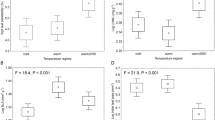Summary
Observations on leaves from plants with a wide range of life-forms, ruderals to trees, indicate that palatability to insect herbivores is strongly correlated with the life-expectancy of the leaves. The amount of damage suffered in the field is however inversely correlated with palatability; although the rate of damage is less on unpalatable leaves, their longer life means that they accumulate damage over a longer period. It is only with extremely well-defended evergreen leaves, that the total damage is less than that experienced by less palatable (but short-lived) leaves. These observations are related to the current theories on relative palatability (the apparency theory and the resource availability theory), within the framework of the habitat templet.
Similar content being viewed by others
References
Brown VK (1984) Secondary succession: insect-plant relationships. Bio Science 34:710–716
Brown VK, Southwood TRE (1983) Trophic diversity in the breadth and generation times of exopterygote insects in a secondary succession. Oecologia (Berlin) 56:220–225
Brown VK, Southwood TRE (1986) Secondary succession: Patterns and strategies. In: Gray A, Edwards P, Crawley MJ (eds) Colonisation, Succession & Stability. Symp Brit Ecol Soc 26 (in press)
Coley PD (1983a) Intraspecific variation in herbivory on two tropical tree species. Ecology 64:426–433
Coley PD (1983b) Herbivory and defensive characteristics of tree species in a lowland tropical forest. Ecol Monographs 53:209–213
Coley PD, Bryant JP, Chapin FS (1985) Resource availability and plant antiherbivore defense. Science 230:895–899
Edlin HL (1985) Broad leaves (2nd ed., revised by Mitchell AF) HMSO
Feeny P (1976) Plant apparency and chemical defense. Rec Adv Phytochem 10:1–40
Greenslade PJM (1983) Adversity selection and the Habitat Templet. Amer Nat 122:352–365
Grime JP (1977) Evidence for the existence of three primary strategies in plants and its relevance to ecological and evolutionary theory. Amer Nat 111:1169–1194
Grime JP (1979) Plant Strategies and Vegetation Processes. J Wiley, New York
Grime JP (1986) Dominant and subordinate components of plant communities — implications for succession, stability and diversity. In Gray A, Edwards P, Crawley MJ (eds). Colonization, Succession & Stability Symp Brit Ecol Soc 26 (in press)
McNeill S, Prestidge RA (1982) Plant nutritional strategies and insect herbivore community dynamics. Proc 5th int Symp Insect-Plant relationships, Wageningen (Pudoc Wageningen)
Painter RH (1951) Insect resistance in crop plants. Macmillan, New York
Peterken GF, Lloyd PS (1967) Ilex aquilifolium L (Biological Flora of the British Isles 108). J Ecol 55:841–858
Rathcke B (1985) Slugs as generalist herbivores: tests of three hypotheses on plant choices. Ecology 66:828–836
Reader PM, Southwood TRE (1981) The relationship between palatability to invertebrates and the successional status of a plant. Oecologia (Berlin) 51:271–275
Rhoades DF, Cates RG (1976) Towards a general theory of plant antiherbivore chemistry. Rec Adv Phytochem 10:168–213
Southwood TRE (1977) Habitat, the templet for ecological strategies? J Anim Ecol 46:337–365
Southwood TRE (1978) Ecological methods with particular reference to the study of insect populations. Chapman and Hall, London
Southwood TRE, Brown VK, Reader PM (1979) The relationships of plant and insect diversities in succession. Biol J Linn Soc 12:327–348
Southwood TRE, Brown VK, Reader PM (1983) Continuity of vegetation in space and time: a comparison of insects' habitat templet in different successional stages. Res Popul Ecol Supplement 3:61–74
Strong DR, Lawton JH, Southwood TRE (1984) Insects on Plants. Blackwells, Oxford
Author information
Authors and Affiliations
Rights and permissions
About this article
Cite this article
Southwood, T.R.E., Brown, V.K. & Reader, P.M. Leaf palatability, life expectancy and herbivore damage. Oecologia 70, 544–548 (1986). https://doi.org/10.1007/BF00379901
Received:
Issue Date:
DOI: https://doi.org/10.1007/BF00379901




